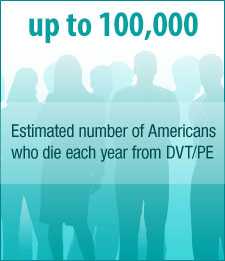Data & Statistics

* The data on this page are from the article, “Venous Thromboembolism: A Public Health Concern.” [Read summary]
- The precise number of people affected by DVT/PE is unknown,although as many as 900,000 people could be affected (1 to 2 per 1,000) each year in the United States.
- Estimates suggest that 60,000-100,000 Americans die of DVT/PE (also called venous thromboembolism).
- 10 to 30% of people will die within one month of diagnosis.
- Sudden death is the first symptom in about one-quarter (25%) of people who have a PE.
- Among people who have had a DVT, one-half will have long-term complications (post-thrombotic syndrome) such as swelling, pain, discoloration, and scaling in the affected limb.
- One-third (about 33%) of people with DVT/PE will have a recurrence within 10 years.
- Approximately 5 to 8% of the U.S. population has one of several genetic risk factors, also known as inherited thrombophilias in which a genetic defect can be identified that increases the risk for thrombosis.
Highlighted Articles
Key Findings: CDC Study Finds People with Blood Clots at Risk of Permanent Work-Related Disability
CDC collaborated on a study of individuals who had participated in two previous Norwegian studies, looking at each participant’s risk of a first-time VTE during 1994-2008. The new study looked at whether or not participants who previously developed a first-time VTE subsequently received a disability pension due to work-related disability.
(Published August 16, 2016)
New Project Findings
CDC project informs efforts to understand and monitor number of people affected by blood clots in US
(Published October 15, 2015)
New Study Findings
Multiple data sources needed for accurate reporting of blood clots after surgery
(Published June 23, 2015)
New VTE Study
Health conditions, hospital characteristics associated with blood clot diagnosis among patients.
(Published June 23, 2015)
New risk factors for VTE
Study explores levels of proteins important in blood clotting as possible new risk factors for VTE
(Published October 15, 2014)
Preventing HA-VTE
VTE is both a public health problem and a preventable patient safety problem.
(Published March 6, 2014)
Use of CT Scans in EDs
Diagnosis of PE associated with and trends in use of CT scans among patients with chest symptoms.
(Published: December 17, 2013)
Are You at Risk for Blood Clots?
Get free tools from the Stop the Clot, Spread the WordTM campaign.
(Published: March 6, 2017)
CDC Challenge Winners
CDC recognized 8 organizations in helping patients prevent healthcare-associated blood clots.
(Published: April 4, 2016)
Learn Signs and Symptoms of DVT
These types of blood clots are preventable and treatable if discovered early.
(Published: March 7, 2016)
Protect Yourself from Blood Clots
If you are currently or recently hospitalized, recovering from surgery, or being treated for cancer, you are at increased risk of developing serious and potentially deadly blood clots.
(Published: October 12, 2015)
Do You Know about Blood Clots and Travel?
Blood clots can be a serious risk for anyone traveling more than four hours.
(Published: March 24, 2014)
Preventing Venous Thromboembolism
(Published: January 7, 2013)
- Page last reviewed: April 6, 2017
- Page last updated: June 22, 2015
- Content source:


 ShareCompartir
ShareCompartir